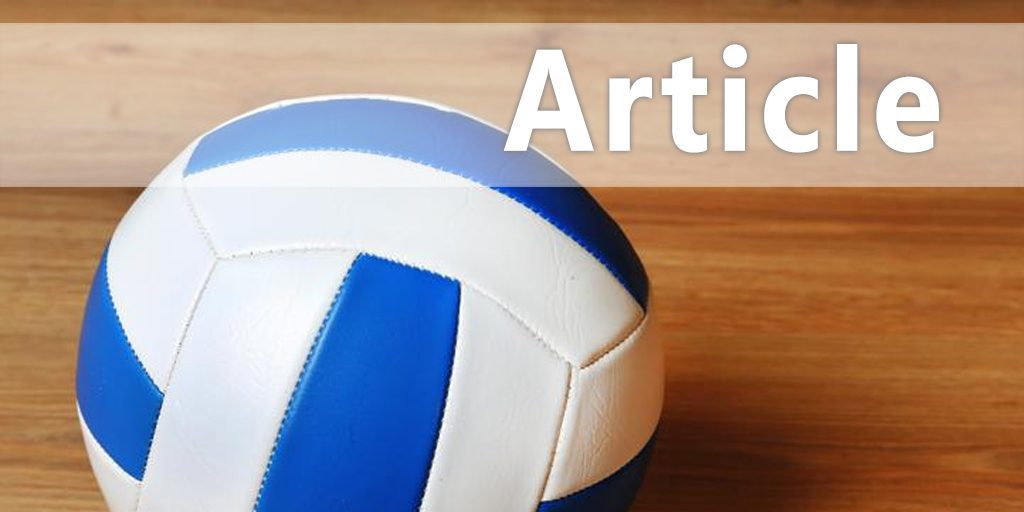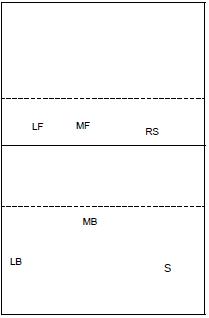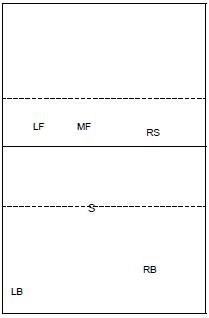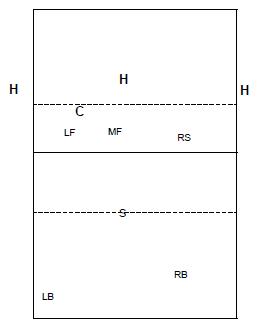|
Defense of Choice:
School of Engineering Provided by The American Volleyball Coaches Association - www.avca.org
Here is a brief overview of both a basic "middle back" or perimeter read defense, and a "middle up" or "rover" defense. We'll look at the differences between the two, each ones strengths and weaknesses, and how to choose what's best for you. Two coaches that volunteered to help with this article are: Josh Lauer, head coach of the University of St. Louis-Missouri (UMSL) and coach of the St. Louis CYC Volleyball Club, and Rich Luenemann, head coach of Washington University-St. Louis. Lauer, now in his third year at UMSL, coaches at the St. Louis CYC Volleyball Club and has helped some of his young players go on to play in college at places like Ohio State University and St. Louis University. He will talk about the "middle back" defense or "perimeter read" defense. Luenemann, whose University of Washington-St. Louis team has won NCAA championships, will discuss the "middle up" defense or "rover" defense, which he is a strong proponent. Perimeter Read Defense The perimeter read defense (Fig. 1) is a basic, deep middle back (also called 6-back) defense in which the team sets up their defense with the back row wings (left back and right back ) positioned 20 feet from the net, pinching the sidelines, while the middle back aligns themselves on the back end line, in the middle of the width of the court.
1. Players can cover a wide amount of court space. Areas of Concern: 1. It is vulnerable to tips and leaves the middle of the floor open. Keys for success 1. Footwork Patterns: Players should shuffle when moving. Work on getting the players to move and shuffle, both forward and back, to get to the ball quickly. 2. Make sure the players keep the court in front of them, and that they play the ball inside the court vs. from outside the court. 3. Read progression: Back row players must be able to read the ball. The read progression or situations to prepare for are as follows: Lauer's comments: "The key to a successful perimeter read defense is a quick libero. We spend a lot of time at practice on perfecting coverage and transition. The left back position has a tendency to stay too deep in the defense, so we stress playing the ball inside the court, facing the court, instead of outside the court. The better footwork and positioning my players have, the more successful we are on the court." Defensive Base of the Rover Defense The rover defense (Fig. 2) is a basic deep middle up (also called 6-up) defense in which the team sets up their defense with back row wings (left back and right back) positioned almost on the end line, 5-feet in from the sideline, while the middle back (played by the setter) covers short tip coverage, roving behind the block. Fig. 2. Defensive Base of the Rover Defense: This figure shows where players are positioned for this type of defense. The red circles indicate the possible gaps or weak areas in the base defense. Basic Concept: Using the rover defense, the setter (if running a back row setter) is closer to their actual transition position, which allows them to make plays more efficiently and quickly. The back row is in a better position to make deep plays on the ball. This defense is also a good tip-covering defense, no matter what offense (6-2, 5-1, 4-2) you are running. Why Should a Rover Defense Be Used? 1. The two deep diggers in the rover defense make outside-in and/or lateral adjustments rather than the inside-out/lateral movements of the man back defensive systems. The outside-in adjustments are more natural movements. 2. If you utilize a Rotation Defense and "commit" your middle back to the sidelines or if your middle back reads and then digs the sideline, that player must become adept at presenting a different digging platform at each corner to direct the ball to the target area. In the Rover Defense, each back row player (right back and left back) has only one sideline to dig ...one mode of platform presentation and re-direction of the ball. 3. If you "read" dig, the rover defense puts the two deep players (right back and left back) in base positions where they have more time to read before they have to adjust and often have less distance to move to dig. Areas of Concern: 1. Blockers must do an excellent job of closing the block and setting up seams for the defensive players in the back row. Keys for success 1. Establish blocking rules and then build back-row assignments around the block. Luenemann comments: "Over a two-year period during matches against NCAA Division II, NCAA Division III, and NAIA teams, I charted where opponents' line shots hit the floor. Eighty percent of those shots landed within 10 feet of the end line. Using the perimeter defense we found our line diggers had difficulty achieving enough depth along the sideline to dig an opponent's line shot. They were often "faced" or "chested." In addition, when the setter in the perimeter defense moved back to dig the sideline, she often found it difficult to transition to offense when the ball wasn't hit to her. The great majority of players I've coached prefer the rover defense after they've become familiar with the reads, responsibilities, and nuances of the defense. They enjoy the outside-in reads, the increase in time to read before reacting, and their enhanced positioning to dig an opponent's quick attacks. When an opponent tips the ball over our block and to our setter, the setter particularly enjoys the opportunity to throw the ball right back over the net to a corner" Practice Drills for Both Perimeter Read or Rover Defense Here are a few drills (Fig. 3) to help you prepare your team for using these defensive schemes. Shadow drills 1. Work on footwork from the defensive base to the coverage, through transition and offensive attack. Then repeat. DO NOT use a ball. Imagery only. 2. Progress to adding a ball. No attack in transition. The coach on the far side tosses a set to the hitters. The coach can use 1, 2 or 3 hitters if desired. The defense reads the blockers, while the hitters cover, transition. The setter sets and hitters catch ball. The coach can control the pace and the tempo of the drill by adding "setter dumps" if necessary. 3. Coach can add a free ball and a set to the hitting team, giving them 10 balls, with the defensive base team having to score "x" amount (coach's choice) of points out of transition. Fig. 3: Positioning for defensive drills. (C=Coach, H=Hitter) Which Defense is Better? Which One Should You Choose? In different situations, there are strengths and weaknesses to both types of defenses. In basketball, is man-to-man defense better than zone? Basketball coaches use a combination of basic defenses to create their own system, or sometimes use all types of defensive schemes to help their team play the best defense. It is the same in volleyball. It is up to the coach to decide what is best for his or her team. As an example, the primary defense we use at MSOE has been a perimeter read defense in the past, but on other teams, we have also won with a rover defense, and actually, a combination of both. Ultimately, the choice is the up to the coach. Look at the type of players you have on your team and ask yourself what are their strengths, what are their weakness and how will the team benefit the most by your decision. Once you determine that, then you can choose the type of defense that will best serve your teams needs.
|
|
|
|











